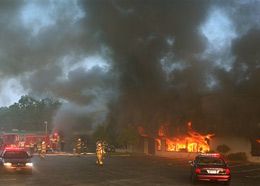By Michael Petroff
 AP Photo/Alexander Fox Smoke billows from the fire at the Sofa Super Store in Charleston, S.C. |
With more than 80 line-of-duty deaths so far this year, the number of LODDs is already on course to exceed the 2006 total of 106.
The United States Fire Administration attributes nine of this year’s deaths to lack of seat belt use, while the same number died in the sofa store blaze in
In the wake of the
These reports and the data concerning seat belt use indicate that firefighters are continuing to ignore safe practices, national standards and case studies of fires.
Several agencies are attempting to reduce firefighter deaths, through the publication of safe practices, studies of incidents and by promoting safety training for all fire personnel. The National Fallen Firefighters Foundation, the Firefighter Near Miss Reporting System, the National Institute for Occupational Safety and Health, and ourselves — the Fire Department Safety Officers Association — are just some of the agencies attempting to coordinate efforts and reduce firefighter deaths and injuries.
The NFFF, for example, has developed the 16 Life Safety Initiatives. These initiatives provide an outline that guides the fire and emergency services to develop safe policies and procedures. Part of these efforts include the Everyone Goes Home Courage To Be Safe program, which presents stories of the survivors of dead firefighters including parents, spouses and fire chiefs. The program also questions our thought process of “Belief – Misconception – Consequences.” The belief exists that a responder does not need to wear a seat belt. The misconception is that an accident will not happen. And the consequence of no belt is injury or death.
NIOSH publishes reports on incidents that result in firefighter LODDs. It also provides policy, procedure and equipment recommendations to prevent recurrences. Along with NIOSH reports, the Near-Miss Reporting System provides case studies that describe tactics, strategy or operational problems that may have resulted in firefighter injury or death. The initiative is supported by both the IAFC and the IAFF, and is funded by grants from Fireman’s Fund Insurance Co. and the United States Fire Administration Assistance to Firefighters Grant program.
Our group, the FDSOA, is an association formed in 1989 to specifically address firefighter safety issues. The organization provides training, educational resources and networking opportunities for the fire service in the
The FDSOA also provides an opportunity for two levels of certification for safety officers — incident safety officer and health and safety officer, and is an accredited agency of the National Board on Fire Service Professional Qualifications.
To facilitate training and certification opportunities, the FDSOA sponsors an Annual Safety Forum, which is held this year in
Presenters at the event will include Chief Billy Hayes of the Riverdale (
In a pre-forum two-day session, individuals can prepare to take the FDISO certification exam by attending the Incident Safety Officer Academy, while those already certified as an ISO can attend the two-day Health and Safety Officer Academy in preparation for the HSO certification exam.
The FDSOA, since its inception, has served as a source for training, certification and continuing education for safety officers. By sponsoring this forum, the FDSOA is providing deliverable means to implement the goal of reducing firefighter deaths and injuries. We hope to see you there — and working to make a difference together.
 |
Michael Petroff is a retired battalion chief from the Ferguson Fire Department of St. Louis County, Missouri. BC Petroff served for more than 32 years, progressing through the ranks. He served on the St. Louis County Overhead response team, and is an instructor for national, state and local fire agencies. BC Petroff is a western region director for the Fire Department Safety Officers Association, a member of the National Fire Protection Association 1021 Committee, a member of the Thomson Delmar Fire Advisory Board, and serves as the region VII regional advocate for the Everyone Goes Home Life Safety Initiatives Program.











